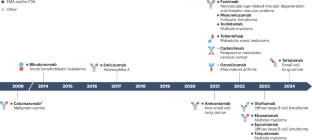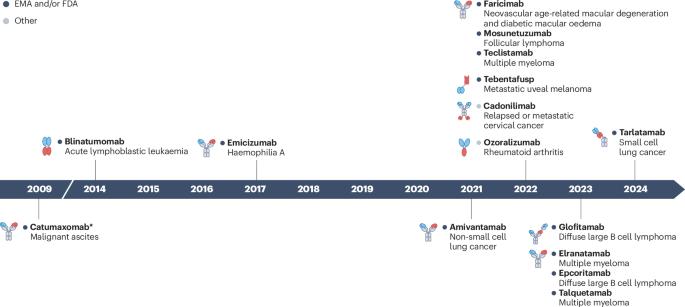分子成像支持多特异性癌症抗体的开发
IF 81.1
1区 医学
Q1 ONCOLOGY
引用次数: 0
摘要
多特异性抗体是经过改造的抗体衍生物,可以与两个或更多不同的表位或抗原结合。与单特异性抗体的混合物不同,多特异性抗体的结合特性使两个特异性分子能够物理连接,这一特性在癌症治疗中有着重要的应用。迄今为止,已有 15 种多特异性抗体被批准用于临床,其中 11 种被批准用于肿瘤适应症,还有 100 多种新抗体正在临床开发中。尽管如此,多特异性抗体在癌症治疗中的应用仍面临巨大挑战,尤其是对实体瘤的靶向效率低和不良反应大。PET 和单光子发射 CT 成像可以揭示放射性标记的多特异性抗体的生物分布和复杂的药理学。本综述总结了多特异性抗体临床前和临床分子成像研究中获得的见解,重点关注其结构特性,如分子量、形状、靶向特异性、亲和力和热敏性。文章还强调了利用分子成像研究支持多特异性抗体疗法临床开发的相关机遇。本文章由计算机程序翻译,如有差异,请以英文原文为准。


Molecular imaging supports the development of multispecific cancer antibodies
Multispecific antibodies are engineered antibody derivatives that can bind to two or more distinct epitopes or antigens. Unlike mixtures of monospecific antibodies, the binding properties of multispecific antibodies enable two specific molecules to be physically linked, a characteristic with important applications in cancer therapy. The field of multispecific antibodies is highly dynamic and expanding rapidly; to date, 15 multispecific antibodies have been approved for clinical use, of which 11 were approved for oncological indications, and more than 100 new antibodies are currently in clinical development. Nevertheless, substantial challenges limit the applications of multispecific antibodies in cancer therapy, particularly inefficient targeting of solid tumours and substantial adverse effects. Both PET and single photon emission CT imaging can reveal the biodistribution and complex pharmacology of radiolabelled multispecific antibodies. This Review summarizes the insights obtained from preclinical and clinical molecular imaging studies of multispecific antibodies, focusing on their structural properties, such as molecular weight, shape, target specificity, affinity and avidity. The opportunities associated with use of molecular imaging studies to support the clinical development of multispecific antibody therapies are also highlighted. Multispecific antibody constructs that bind several distinct targets can connect cells and/or simultaneously target multiple molecules. Here, Lub-de Hooge et al. discuss the varied contributions of molecular imaging to multispecific antibody design, drug development and optimization, including evaluations of antibody biodistribution and pharmacological complexity.
求助全文
通过发布文献求助,成功后即可免费获取论文全文。
去求助
来源期刊
CiteScore
99.40
自引率
0.40%
发文量
114
审稿时长
6-12 weeks
期刊介绍:
Nature Reviews publishes clinical content authored by internationally renowned clinical academics and researchers, catering to readers in the medical sciences at postgraduate levels and beyond. Although targeted at practicing doctors, researchers, and academics within specific specialties, the aim is to ensure accessibility for readers across various medical disciplines. The journal features in-depth Reviews offering authoritative and current information, contextualizing topics within the history and development of a field. Perspectives, News & Views articles, and the Research Highlights section provide topical discussions, opinions, and filtered primary research from diverse medical journals.

 求助内容:
求助内容: 应助结果提醒方式:
应助结果提醒方式:


